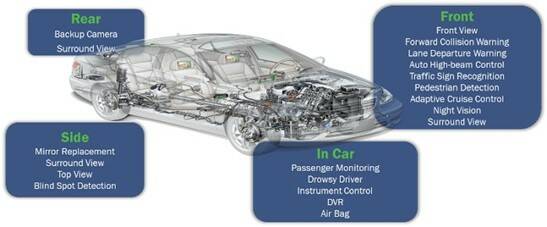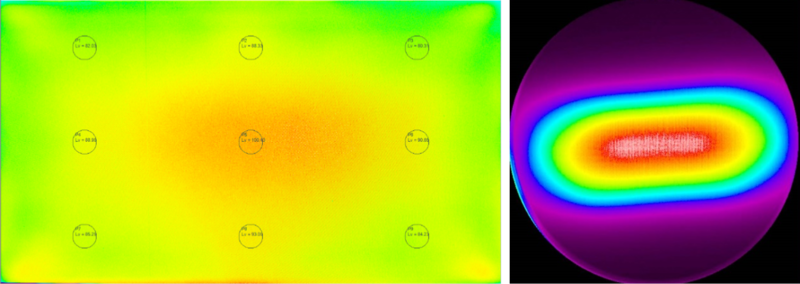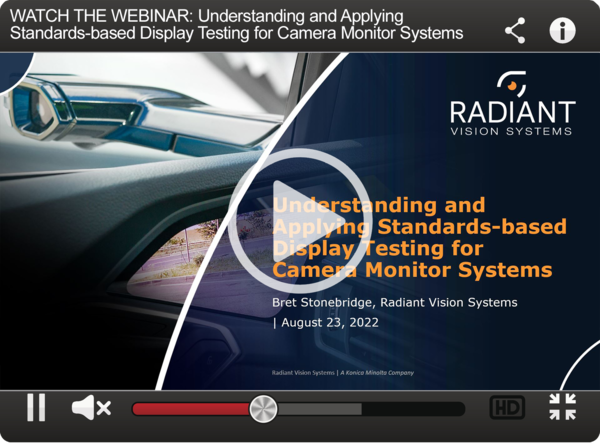Quality Testing Camera Monitoring Systems (CMS) to Meet Automotive Standards
Several weeks ago, I bought a new car after driving my old vehicle for 17 years. I’m very excited that the new model is a hybrid gas/electric-powered vehicle that offers great fuel efficiency and low emissions. And I’m particularly excited about all the technology-enabled Advanced Driver Assistance System (ADAS) features that didn’t even exist 17 years ago: back-up cameras, sensors and warnings, and various camera monitoring system (CMS) functions.

Some vehicles today are equipped with dozens of sensors and cameras to provide a full array of ADAS functions. (Image © Onsemi)
Camera Monitoring Systems Are the New Mirrors
Used in place of side- and rear-view mirrors, a CMS offers advantages for vehicle safety and function—eliminating blind spots, reducing glare, and improving aerodynamics. Mirrors have been standard vehicle components since the mid-to-late 1960s, which is when we started to see increased safety standards around indirect visibility. For several decades, side- and rear-view mirrors have been mandatory in the vehicle interior and exterior.
In the past few years, however, mandatory vehicle mirrors have been targeted for replacement by display-based systems in both passenger and commercial vehicles. CMS mirrors can provide a number of safety benefits, including:
- Improved situational awareness – A CMS can eliminate blind spots because the cameras can “see” areas outside the vehicle that are otherwise blocked from the driver’s view. Cameras can also be used to expand the field of view (FOV) beyond the limitations of what a single mirror can reflect.
- Improved object visibility – Unlike images seen in a mirror, digitally captured camera images can be enhanced to improve brightness, color, and contrast of the video feed shown to the driver. Camera systems can also automatically reduce the glare from headlights (no more having to flip the rear-view mirror angle to avoid being blinded by the car behind you).
CMS systems are already being adopted for mirror replacement and other indirect-visibility scenarios for vehicles in the European, Asian, and North American markets. The global market for overall automotive cameras is booming. Growth predictions range from 12% CAGR1 through 2027 to a 24.3% CAGR2 through 2028, with segment revenues forecast to increase anywhere from 2x to more than 4x in the next 5-6 years.

Example of a traditional rear-view mirror (left) and a CMS display mirror (right).
But replacement of regulated mirrors by cameras has only been legal for a few years in Japan and Europe—and is still under review in the US and Canada. As with any new automotive feature, regulatory agencies are looking closely at these technologies, their implementation, and their performance. Automotive components used for indirect visibility need to meet strict standards for compliance, and CMS are no exception.
OEMs and CMS manufacturers must ensure their product quality testing regimens adhere to all of the latest standards. This can be complicated by the fact that “each individual camera has its own unique features ranging from different resolutions, optical formats, Color Filter Arrays (CFA), lens types, Automotive Safety Integrity Level (ASIL) functions and transmission protocols.”3
Keeping Up with Motor Vehicle Standards and Regulations
Even though its not yet legal in the USA to replace the mandatory mirrors using CMS, many vehicles on the road today already have a CMS system onboard—the back-up camera. In fact, CMS backup cameras have been required in all new vehicles manufactured in the USA since May 1, 2018. These systems are regulated by the FMVSS 111 Rear-visibility standard through NHTSA.
The National Highway Traffic Safety Administration (NHTSA) is quickly progressing to approve CMS as a rear visibility system governed by Federal Motor Vehicle Safety Standard (FMVSS) No. 111. To ensure compliance, the recently issued SAE J3155 Recommended Practice “Camera Monitor Systems Test Protocols and Performance Requirements” outlines methods for testing CMS optical, electrical, mechanical, and functional effectiveness.
Manufacturers planning to incorporate CMS need to understand the protocols of SAE J3155 and how to apply them. In particular, equipment selected to test optical performance of the CMS display—although not specified by SAE—has a great impact on overall testing cost, speed, and ease as compared to alternative systems.
The SAE standards, and their parallel standards and regulations in the European Union and other nations, are detailed and rigorous. Multiple aspects of display performance must be tested:
- Image Quality – uniformity, color, contrast, brightness, resolution, sharpness, distortion
- Time Behavior – frame rate, image formation time, system latency
- Artifacts – blooming, lens flare and smear, point sources, flickering sources
- Durability and Ergonomics – durability, gloss, glare

Examples of CMS tests following ISO 16505, with images shown in false color scale. Left: Measuring luminance deviation at x,y points as viewed from a 0,0 perpendicular (lateral uniformity). Right: measuring luminance deviation at different viewing angles (directional uniformity).
To learn more about CMS display standards, how companies are tackling these new testing requirements, and different test solutions, watch the webinar “Understanding and Applying Standards-based Display Testing for Camera Monitor Systems,” hosted by Engineering360 (GlobalSpec). In it, Radiant Sales Manager Bret Stonebridge discusses the SAE J3155 Recommended Practice for testing CMS according to U.S. regulations and provides considerations for selecting a display measurement system with advantages for optimal efficiency.

CITATIONS
- Automotive Camera Market – Growth, Trends, COVID-19 Impact, and Forecast (2022-2027), Mordor Intelligence. (Accessed September 8, 2022)
- Automotive Camera Market Forecast to 2028, Insight Partners, July 5, 2022.
- “Optimizing the Automotive Camera Development Phase Using a Modular Design Approach,” Onsemi website: https://www.onsemi.com/company/news-media/blog/automotive/optimizing-automotive-camera-development. (Accessed September 8, 2022)
Join Mailing List
Stay up to date on our latest products, blog content, and events.
Join our Mailing List
